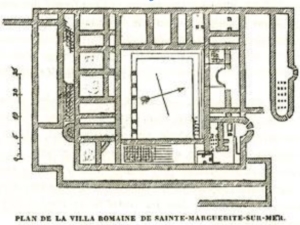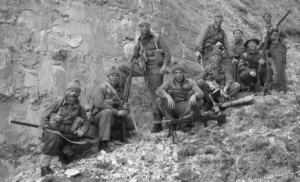
Sainte-Marguerite-sur-Mer is a Normandy village on the edge of a cliff on the Côte d'Albâtre.
Distant from Dieppe by 13 km, Longueil, Varengeville-sur-Mer and Quiberville-sur-Mer border it.
Originally known as Caprimont, from Latin capra (goat): The goat hill.
It was successively named Quievremont (1319), Chievremont (1337), Chèvremont (1426) and Sainte-Marguerite de Quievremont (1517),
Quievremont sur la Merentre 1503, Ecclesia Sanctae Margaritae de Quièvremont in 1703, Sainte-Marguerite de Caprimont in 1714, Caprimont sur la mer in 1726, Sainte-Marguerite de Caprimont in 1736, Sainte Marguerite de Caprimont in 1715, Sainte-Marguerite de Quevremont before the French Revolution, then Quevremont in 1788.
During the French Revolution, the commune was temporarily named Phare-de-l'Ailly.
Upon restoration, it was renamed Sainte-Marguerite.
It wasn't until 1953 that the word sur-Mer was added.
Roman origins

Julius Caesar was the first to give details of the region in La guerre des Gaules (58-50 BC).
He called the tribe living in the region bordering the sea north of the Seine (Belgica) Calètes(Durs).
The Calètes, probably of Germanic origin, gave their name to the Pays de Caux, Pays des Calètes.
The most important remains from the Gallo-Roman period in Seine-Maritime are those of the villa at Ste-Marguerite, in a place called Butte de Nolent (literally "mud hill" in Scandinavian).
The site was discovered in 1820 by a ploughman who unearthed a fragment of mosaic. Five others were subsequently discovered; hence the name given to this one: Les Mosaïques.
The first excavations were carried out between 1821 and 1825.
From 1840 to 1847, more methodical research led to the discovery of an entire Villa measuring 60 m x 45 m and its outbuildings.
A relief map, on display at the Dieppe museum, was produced.
Villa, in Latin, refers to a large, wealthy residence. It probably belonged to a governor in charge of guarding the coast.
Numerous remains uncovered on the banks of the Saâne throughout the 19th century - cemetery, traces of dwellings - indicate that Ste-Marguerite was an important place at the time (the portus veneti mentioned by Caesar?).
Was Sainte-Marguerite-sur-Saâne a port at the time? We can assume so, as the Roman road linking Lillebonne (Juliobona), capital of the Calètes, passed through here before continuing on to Dieppe and beyond (at Braquemont, the earthworks of Caesar's Camp are still visible).
In 1868, Abbé Cochet, Inspecteur Départemental des Monuments Historiques, compiled in a single work the results of the various investigations carried out since the discovery of the site, adding his own, begun in 1862 (republished by Ed. Bertout in 1984).
Today, the saved mosaics can be seen in Dieppe and Rouen, and the site is covered to prevent damage and theft.
August 19, 1942, Ste-Marguerite, theater of operations
On the morning of August 19, Lord Lovat, who would later illustrate himself during the Normandy landings, disembarked with

its 4th commando on Ste-Marguerite beach, renamed Orange beach. The 160 men, including 3 French, advanced rapidly inland along the Sâane valley. The aim was to overtake the powerful coastal battery of 6 150 mm guns that blocked the entrance to the port of Dieppe. At the same time, Mills-Robert - Lovat's deputy - and his 90 men attacked head-on through the Vasterival valley. The two groups charged with bayonets, neutralizing the battery, destroying the guns and returning to the beach, from where they reembarked, taking their prisoners with them.
A model of execution, this was the only phase of Operation Jubilee that went according to plan.
Today, Sainte Marguerite-sur-Mer's calm and gentle way of life appeal to lovers of nature and authenticity.
A resort center, the village features villas, hotels, gîtes, B&Bs, farm camping and restaurants.
The lighthouse dominates the Pointe de l'Ailly woodland, offering a magnificent panorama of the sea and surrounding countryside.
